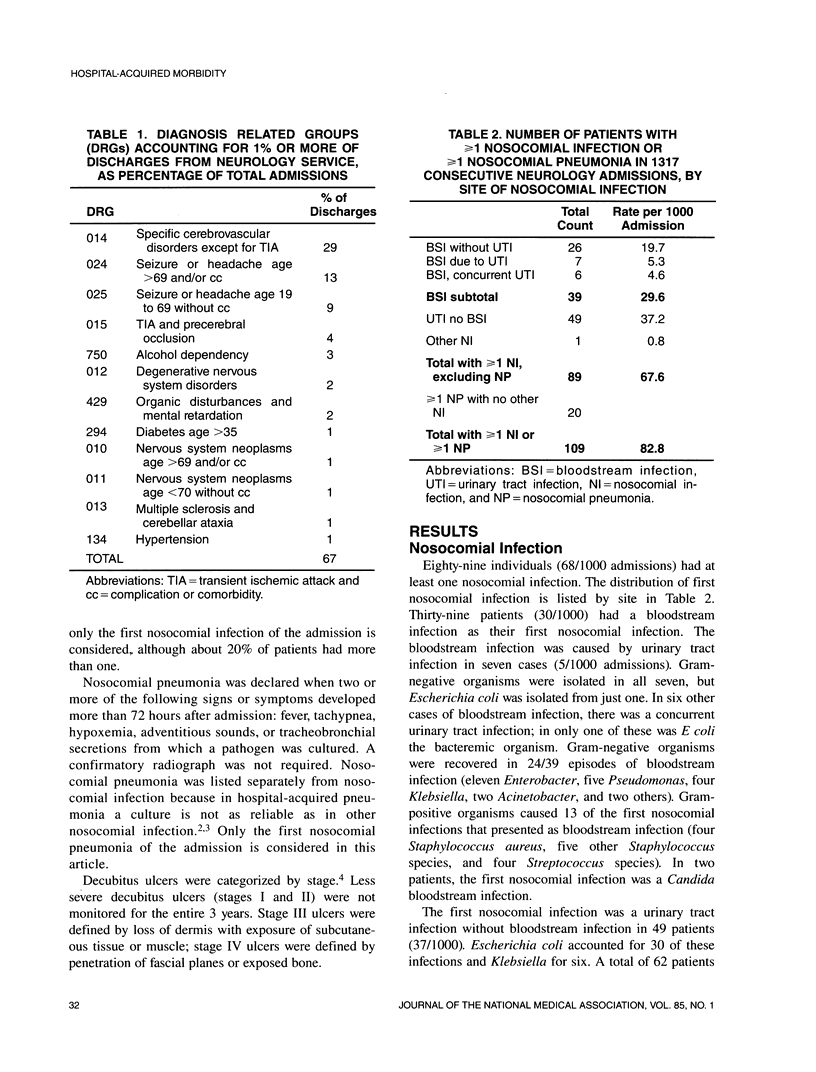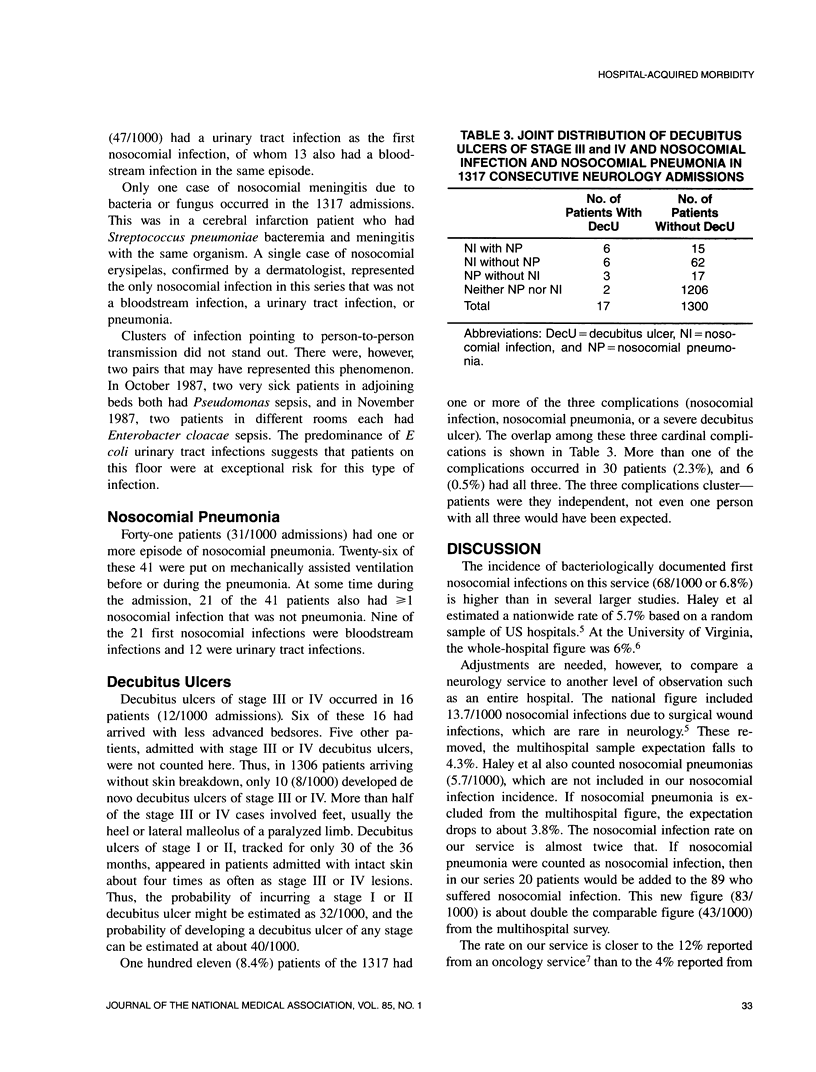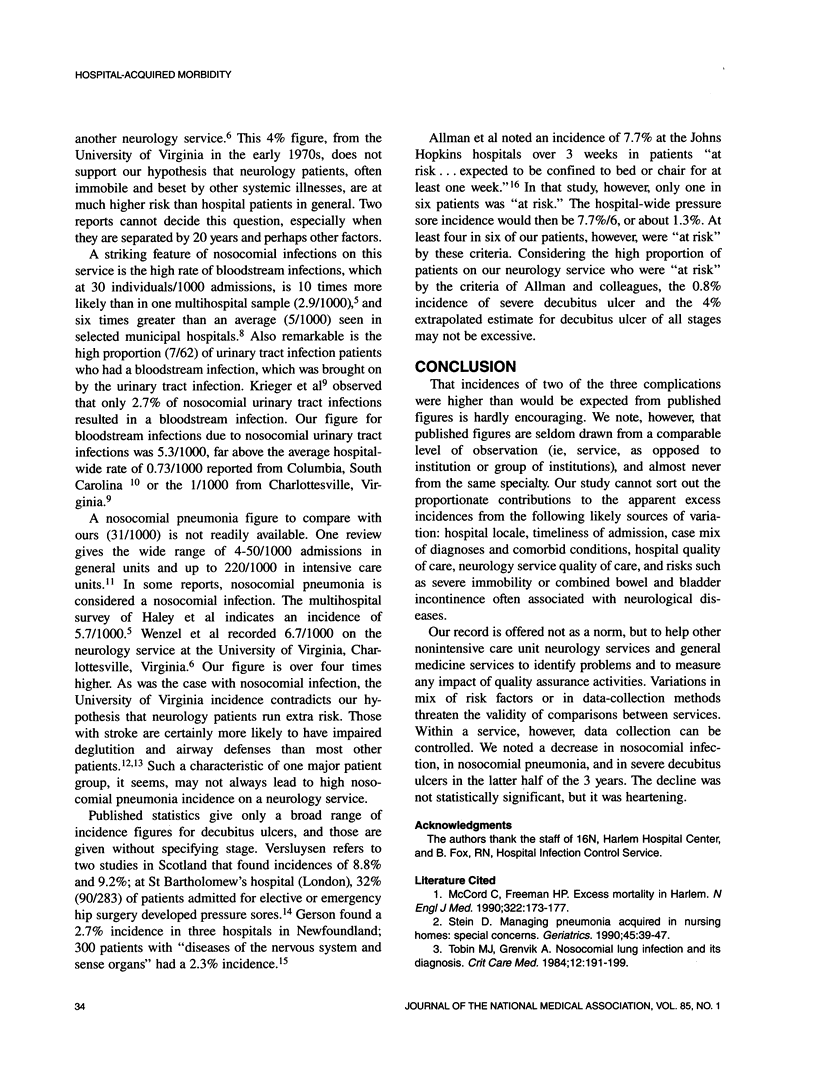Abstract
Clinical services must monitor hospital-acquired morbidity, but what rates are expected specifically for neurology inpatients is not evident from published studies. We studied prospectively 1317 consecutive admissions to a neurology service in a university-affiliated city hospital from 1987 to 1990 and recorded all nosocomial infections, nosocomial pneumonia, and decubitus ulcers of stage III or IV. Over the 3-year period, 6.8% of patients had > or = 1 nosocomial infection (and almost half of these had a nosocomial bloodstream infection); 3.1% had > or = 1 case of nosocomial pneumonia; 1.2% developed severe decubitus ulcers, and 8.4% had one or more of the three complications. The incidence of nosocomial infection exceeds that expected from multihospital studies. How much of the excess is peculiar to neurology patients and how much can be attributed to factors in our community and at our hospital cannot be determined from this study. Furthermore, our statistics are not meant as norms, but as initial estimates for quality assurance.
Full text
PDF




Selected References
These references are in PubMed. This may not be the complete list of references from this article.
- Allman R. M., Laprade C. A., Noel L. B., Walker J. M., Moorer C. A., Dear M. R., Smith C. R. Pressure sores among hospitalized patients. Ann Intern Med. 1986 Sep;105(3):337–342. doi: 10.7326/0003-4819-105-3-337. [DOI] [PubMed] [Google Scholar]
- Bryan C. S., Reynolds K. L. Hospital-acquired bacteremic urinary tract infection: epidemiology and outcome. J Urol. 1984 Sep;132(3):494–498. doi: 10.1016/s0022-5347(17)49707-2. [DOI] [PubMed] [Google Scholar]
- Celis R., Torres A., Gatell J. M., Almela M., Rodríguez-Roisin R., Agustí-Vidal A. Nosocomial pneumonia. A multivariate analysis of risk and prognosis. Chest. 1988 Feb;93(2):318–324. doi: 10.1378/chest.93.2.318. [DOI] [PubMed] [Google Scholar]
- Gerson L. W. The incidence of pressure sores in active treatment hospitals. Int J Nurs Stud. 1975;12(4):201–204. doi: 10.1016/0020-7489(75)90025-5. [DOI] [PubMed] [Google Scholar]
- Haley R. W., Culver D. H., White J. W., Morgan W. M., Emori T. G. The nationwide nosocomial infection rate. A new need for vital statistics. Am J Epidemiol. 1985 Feb;121(2):159–167. doi: 10.1093/oxfordjournals.aje.a113988. [DOI] [PubMed] [Google Scholar]
- Horner J., Massey E. W. Silent aspiration following stroke. Neurology. 1988 Feb;38(2):317–319. doi: 10.1212/wnl.38.2.317. [DOI] [PubMed] [Google Scholar]
- Krieger J. N., Kaiser D. L., Wenzel R. P. Urinary tract etiology of bloodstream infections in hospitalized patients. J Infect Dis. 1983 Jul;148(1):57–62. doi: 10.1093/infdis/148.1.57. [DOI] [PubMed] [Google Scholar]
- Maki D. G. Nosocomial bacteremia. An epidemiologic overview. Am J Med. 1981 Mar;70(3):719–732. doi: 10.1016/0002-9343(81)90603-3. [DOI] [PubMed] [Google Scholar]
- McCord C., Freeman H. P. Excess mortality in Harlem. N Engl J Med. 1990 Jan 18;322(3):173–177. doi: 10.1056/NEJM199001183220306. [DOI] [PubMed] [Google Scholar]
- Rotstein C., Cummings K. M., Nicolaou A. L., Lucey J., Fitzpatrick J. Nosocomial infection rates at an oncology center. Infect Control. 1988 Jan;9(1):13–19. [PubMed] [Google Scholar]
- Shea J. D. Pressure sores: classification and management. Clin Orthop Relat Res. 1975 Oct;(112):89–100. [PubMed] [Google Scholar]
- Stein D. Managing pneumonia acquired in nursing homes: special concerns. Geriatrics. 1990 Mar;45(3):39-42, 47. [PubMed] [Google Scholar]
- Tobin M. J., Grenvik A. Nosocomial lung infection and its diagnosis. Crit Care Med. 1984 Mar;12(3):191–199. doi: 10.1097/00003246-198403000-00008. [DOI] [PubMed] [Google Scholar]
- Wenzel R. P., Osterman C. A., Hunting K. J. Hospital-acquired infections. II. Infection rates by site, service and common procedures in a university hospital. Am J Epidemiol. 1976 Dec;104(6):645–651. doi: 10.1093/oxfordjournals.aje.a112343. [DOI] [PubMed] [Google Scholar]


